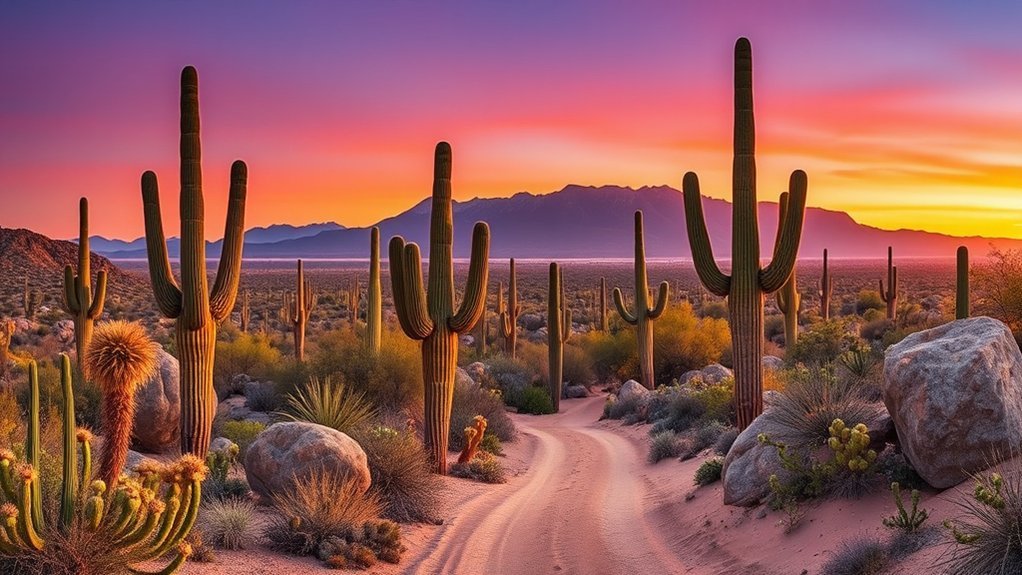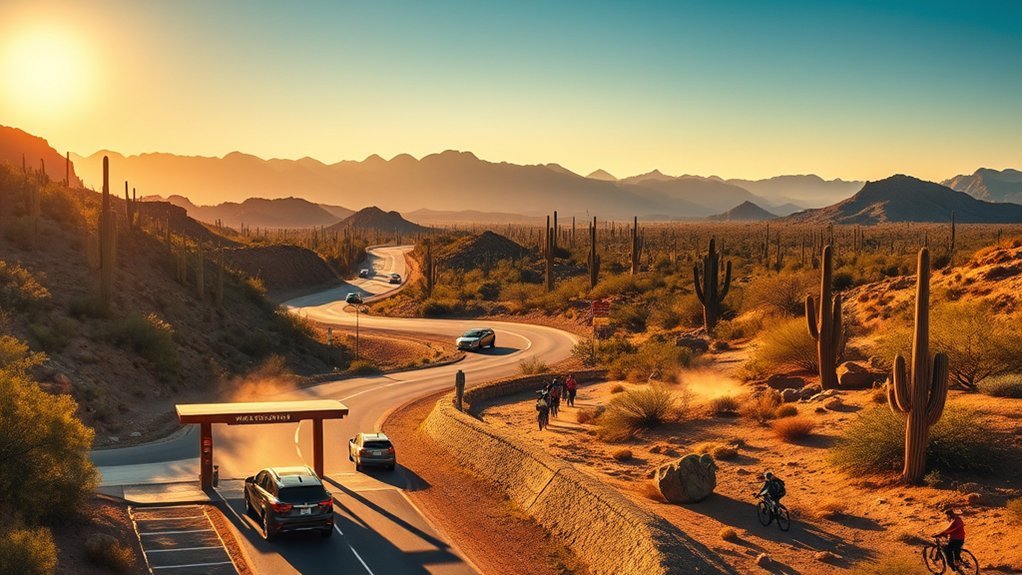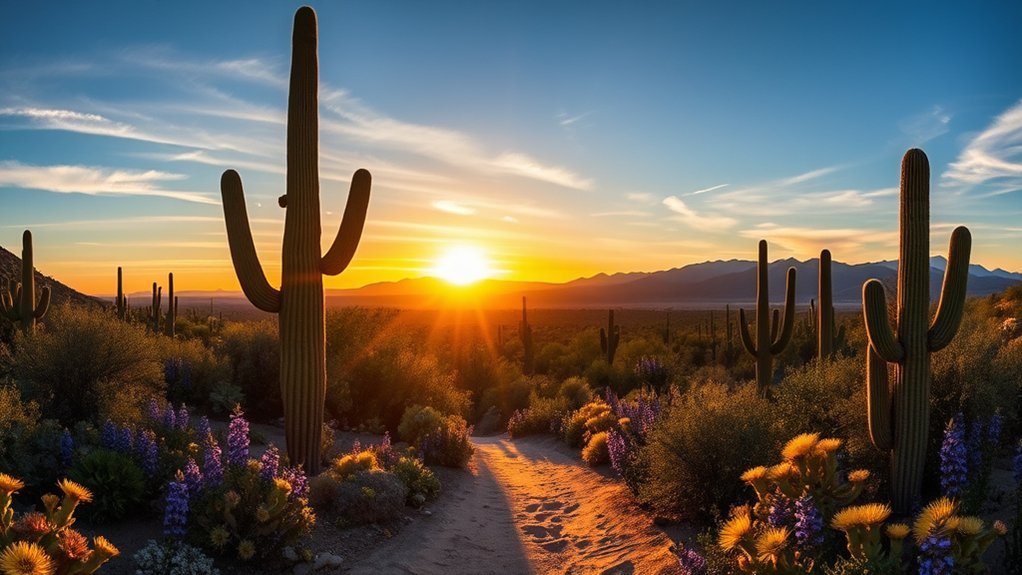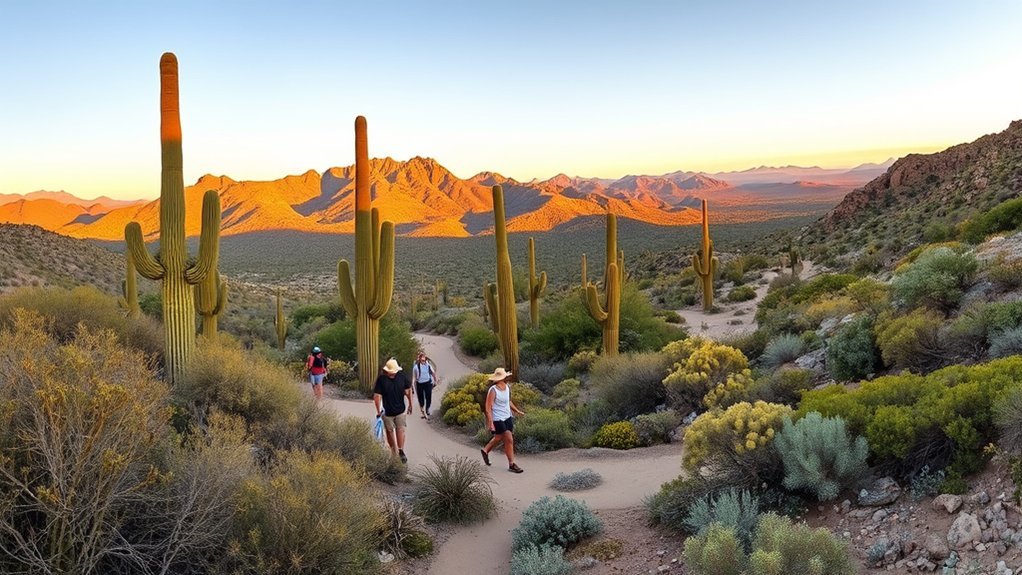You’ll find Saguaro National Park offers a unique desert experience centered on the iconic saguaro cactus and rich Sonoran biodiversity. This guide will help you plan travel logistics, pick the best seasons, choose accessible hikes and scenic drives, and prepare for desert conditions. Follow practical tips for safety, parking, and wildlife viewing—and keep going to make sure your visit is well-timed and trouble-free.
About Saguaro National Park and Its History

Saguaro National Park protects the iconic saguaro cactus and the Sonoran Desert landscape that’s defined the region for centuries. You’ll learn that the area was established in 1933 as Saguaro National Monument to safeguard these giants from development, later expanded and redesignated a national park to strengthen protection. The park spans over 91,000 acres and is split into Rincon Mountain District (east of Tucson) and Tucson Mountain District (west), each offering distinct terrain and habitats. You’ll see saguaros that can reach 60 feet and live two centuries, central to Sonoran Desert ecology. Over time the landscape’s biodiversity—more than 350 bird species and varied desert flora—shifted perceptions from harsh to profoundly valuable.
Getting There and Park Access

Plan on approaching the park from Tucson—it’s about a 30-minute drive from downtown (roughly two hours from Phoenix via I‑10)—and use the district addresses (Rincon Mountain: 3693 S. Old Spanish Trail; Tucson Mountain: 2700 N. Kinney Road). For straightforward Saguaro National Park entrance and park access, head to the East and West districts as your itinerary dictates. You won’t need reservations; standard entry fees ($15–$25 per vehicle) cover seven days. Both visitor centers supply maps, guides, and staff who’ll answer navigation questions and brief you on current road conditions. Drive with the posted directions and use the specific addresses rather than general map apps when possible. That approach keeps your arrival efficient and reduces confusion at trailheads.
Best Time to Visit and Seasonal Tips

If you want the most striking displays of bloom and comfortable weather, visit in April or May when the park’s cactus flowers erupt in magenta, red, white, and yellow and temperatures are mild. That’s the best time to visit Saguaro National Park for the vibrant cactus flower season and easy access to its diverse ecosystems. Winter temperatures run in the high 50s to mid-70s, attracting crowds during the busy season from November through March. Plan for shoulder months—spring or fall—if you want milder temperatures and fewer people. Avoid July’s monsoon season because storms can cause flash floods and limit outdoor activities; summer heat frequently tops 100°F and is unsafe for prolonged exposure. Pack layers and check forecasts before you go.
Top Activities and Recommended Hikes

When you visit, you’ll find a range of activities and hikes that suit every skill level and let you experience the Sonoran Desert up close. You can choose easy or moderate hiking trails like the 0.8-mile Valley View Overlook or the 2.5-mile Cactus Forest Trail to study diverse desert landscapes. Ranger-led programs and guided tours by jeep, e-bike, or foot deepen your understanding of the ecosystem and history.
- Hike Signal Hill Trail (0.3 mi) to see Hohokam petroglyphs.
- Ride or drive Cactus Forest Drive (8 mi paved) for iconic saguaro views.
- Explore Bajada Loop Drive (6 mi gravel) for varied terrain.
- Watch sunset views from Javelina Rocks or Tanque Verde Ridge.
Where to Stay, Eat, and Practical Visitor Info

Looking for a place to stay or grab a bite while exploring Saguaro National Park? You’ll find no traditional lodging inside the park, so plan bases in nearby Tucson or historic dude ranches. Gilbert Ray Campground near the Tucson Mountain District provides affordable tent sites with water spigots and restrooms. Bring food and water—there are no concessions in the park.
| Option | Location | Notes |
|---|---|---|
| Camping | Gilbert Ray Campground | Tent sites, water spigots, restrooms |
| Ranches | Tanque Verde, White Stallion | Historic dude ranches, immersive stays |
| Hotels & Rentals | Downtown Tucson, Solana Spanish Villas | Hotel accommodations, rental properties, dog-friendly |
For dining options, downtown Tucson offers varied choices. This visitor info helps you plan smart, safe visits.
Frequently Asked Questions
Are There Guided Night Programs or Stargazing Events in the Park?
Yes — you can join ranger-led programs, astronomy workshops, moonlight hikes and stargazing locations; consult the celestial events calendar for times, use telescope rentals, follow night photography tips, dark sky initiatives and nocturnal wildlife viewing guidance.
Can I Bring My Dog on Park Trails or in Visitor Centers?
Yes — you can bring your dog, but you’ll follow leash requirements and park regulations overview: obey dog park rules, trail etiquette guidelines, pet hiking safety and wildlife encounters tips, respect seasonal restrictions, canine friendly areas, and visitor center policies.
Are There Restrictions on Drone Use Within Park Boundaries?
Yes — you can’t fly drones; park drone regulations ban them to protect wildlife disturbance, guarantee park safety and conservation efforts, limit environmental impact, support photography policies, guide technology use, preserve park access, visitor education, and recreational activities.
Where Can I Report Injured or Vandalized Saguaros?
Report injured or vandalized saguaros to park ranger contact immediately; you’ll follow reporting procedures explained, supporting saguaro conservation efforts, local wildlife protection, visitor responsibility guidelines, environmental impact awareness, community involvement initiatives, restoration projects updates, educational programs offered, volunteer opportunities available.
Is Hunting or Fishing Allowed in Saguaro National Park?
No — you can’t hunt in Saguaro National Park; fishing’s also prohibited within park boundaries. You’ll follow hunting regulations and fishing permits elsewhere, heed seasonal restrictions, safety guidelines, permitted activities, ecological impact, wildlife conservation, fishing locations, hunting zones.
Conclusion
You’ll plan carefully, pack water, and arrive expecting desert solitude—only to be humbled by how alive the saguaro forest feels. Ironically, the place you thought would offer quiet isolation teaches you community: spiny sentinels, nesting birds, and fellow visitors all woven into a fragile ecosystem. Respect the rules, stay on trails, and you’ll leave richer for having been brief and small inside something immense and patiently enduring.

